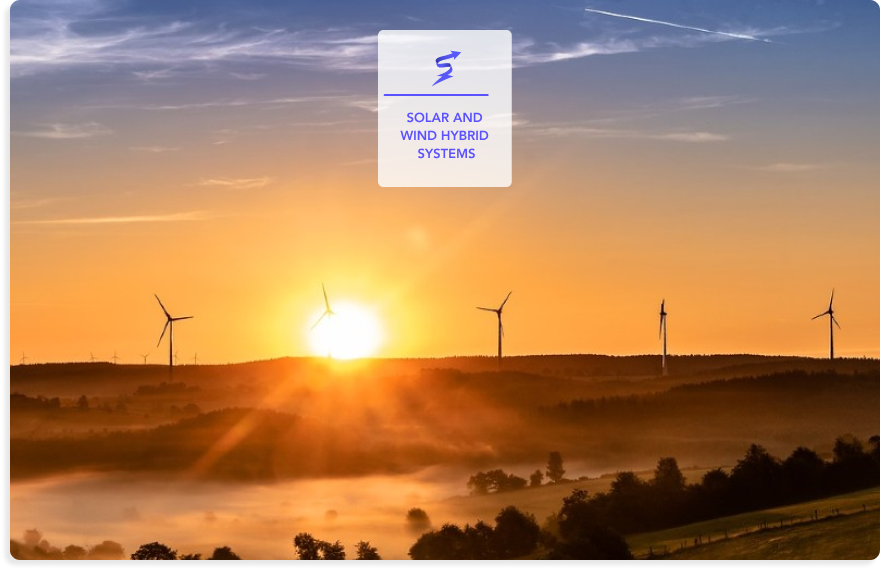Solar and wind hybrid systems: how do they work?

Are you ready to make the switch?
Switching energy suppliers has never been easier. Simply let our experts cater to all
of your gas and electricity needs.
Notice
Energy suppliers, eco-conscious energy consumers and the energy watchdog Ofgem all agree that renewables are the future of the UK’s energy industry. As of Q1 2020, renewables have begun to form over 50% of our national energy fuel mix, with wind energy and solar generating 41.14% of our nation’s energy between them. Both solar and wind power are infinitely renewable clean forms of energy generation. What’s more, hundreds of thousands of homes are using solar panels and domestic wind turbines to create their own clean, off-grid energy. But did you know that with solar and wind hybrid systems, self-sufficient Brits can get the best of both worlds?
Last updated: November 2022

What is a solar and wind hybrid system?
Solar and wind hybrid systems incorporate a Photovoltaic (PV) solar panel with a domestic wind turbine. These are usually placed on the rooftops of homes and businesses.
A solar and wind hybrid system generates energy all year round rather than just in daylight hours. What’s more, the two energy sources do a very good job of supporting one another.
Wind pressure tends to be low when the days are warm and sunny, and the PV solar panel can work its magic. On the other hand, during twilight hours or on a grey and cloudy day, where a solar panel would typically generate less electricity, a wind turbine can thrive.
Although many use both solar and wind power to supplement grid energy or benefit from Feed in Tariffs and Smart Export Guarantees, many hybrid systems are totally off the grid. However, this typically requires the system to incorporate a battery bank to maximise usable energy generated by solar power, or a diesel generator that may offset some of the sustainability benefits.

Looking for the best energy deals?
Free Service
Request a callback from our experts at Switch Plan to help you find
the best energy contract .
More info
What does a hybrid energy system consist of?
Hybrid energy systems usually consist of a PV solar panel connected to a domestic wind turbine. This is the simplest hybrid system and can be used to supplement energy from the grid and potentially offset the cost of grid energy by pumping excess electricity back into the grid that is paid for by the supplier on a Feed in Tariff. These Feed in Tariffs have recently been replaced with Smart Export Guarantees, although the rates are virtually identical and they are the same in all but name.
More complex hybrid energy systems, however, may incorporate a battery bank to store solar energy that is generated in excess. This is usually the case in off-grid systems. In many instances, a diesel generator may also kick in to provide energy where there is a gap between the present load and what the wind turbine and solar panels are able to generate between them.
A controller will also be needed to automatically manage these systems and ensure an uninterrupted energy supply.
![]()
What are the advantages of a hybrid system?
In many ways, a hybrid system offers eco-conscious energy consumers the best of both worlds.
Advantages of hybrid systems include:
A continuous power supply
The solar and wind energy generation do a great job of complementing one another’s inherent challenges and inefficiencies. And between them, they can reduce reliance in the National Grid better than any single system. When the sun goes down, winds usually pick up. And when the winds die down, it’s usually because the sun has risen.
Low maintenance
Once the hybrid system is up and running, it doesn’t require regular servicing and is cheap and easy to maintain.
Highly efficient
Hybrid systems work efficiently in a wide range of conditions. What’s more, a hybrid system that utilises batteries to store solar energy is even more efficient as no excess energy is wasted. Hybrid systems also have effective load management, ensuring that the energy generated meets your needs more efficiently than a standalone generator.
What are the disadvantages of a hybrid system?
While solar and wind hybrid systems are certainly advantageous, they are not infallible. Let’s take a look at the disadvantages of hybrid systems:
Costly and complicated installation
Although inexpensive hybrid systems can be purchased for as little as £400, a more complicated setup with a battery bank and backup diesel generator can be much more expensive and complicated to install.
Controlling can be complicated
Hybrid systems are more difficult and complicated to control than either wind turbines or solar panels on their own. Managing their interaction and coordination optimally can be extremely difficult for an amateur.
Compromised batteries
Exposure to the elements could compromise the life of the batteries in your bank, adding to the system’s costs and creating potential sustainability compromises.
Find the perfect energy supplier for your solar and wind hybrid system
If your hybrid system is connected to the grid, it’s imperative to find the right energy supplier for your needs. A supplier who will give you the best rates on their Feed in Tariffs or Smart Export Guarantees to ensure that your hybrid system becomes profitable sooner.
However, scouring the market to find the best tariffs can be a frustrating and time-intensive pursuit. The good news is that we can help you find the perfect supplier and tariff for your needs, whether you’re using a solar array, domestic wind turbine, or both.
Sound good?
Get in touch with us today on 0330 818 6223 to find out more. We’re available from 8.30 am to 5.30 pm.
Would you like to know more about generating electricity? Great! Check out these related articles
- Smart Export Guarantee
- Home wind turbine
- Small scale hydropower
- Kinetic floor tiles
- Geothermal heating
FAQ
Can you combine solar and wind power?
Yes, and they can work in tandem very well. The wind turbine can be especially effective at night or at times when the sun is obscured by cloud. PV solar panels can supplement and enhance the energy output of wind turbines to create more renewable energy. When a battery pack and an external generator are added to the setup, a solar and sind hybrid system can even allow self-sufficient energy consumers to live completely off the grid.
Can you store the power from solar and wind hybrid systems?
Yes. While a hybrid system can feed energy back into the National Grid (and offset the cost of any grid energy that’s needed), it’s also possible to add a battery bank to your hybrid system. This ensures that the energy generated during daylight hours is not wasted, and adds to the system’s overall efficiency.
What are the different kinds of hybrid systems?
There are a number of different variations on the solar and wind hybrid system. The simplest combine a PV solar panel and wind turbine to feed energy into the home and pump any excess back into the national grid.
Off-grid versions will incorporate a battery bank to store solar energy not used during the day. On occasions where the energy load cannot be met by both wind turbine and solar panel, a diesel generator may be used to ensure an uninterrupted energy supply.
A solar hybrid system may also apply to a solar / thermal hybrid system. This is an array with two kinds of solar panels. One is the PV solar panel that generates energy, while the other transfers heat from its surface to a storage tank.
Does a solar and wind hybrid system need to use a diesel generator?
Not necessarily. The eco-conscious may baulk at the idea of using a fossil fuel like diesel to power their homes. Even if it’s just on occasions where the energy generated by the wind and solar systems is not equal to the current energy load. This is usually only necessary for completely off-grid systems. And even then it may not be necessary when there is sufficient solar energy stored in the system’s batteries.
Updated on 29 Jan, 2024
William Dautel
UK Content Manager
William is a content marketing specialist. After 3 years writing brand strategies he joined papernest to help create the best content to help people handle and save on their utilities.
William is a content marketing specialist. After 3 years writing brand strategies he joined papernest to help create the best content to help people handle and save on their utilities.
Comments